Speech Mortgage Insights From Securitisation Data
Introduction
Good afternoon. It's a pleasure to be here today and I would like to thank the Australian Securitisation Forum for their invitation.
Today, I will talk about the Securitisation Dataset, which has detailed data on mortgages underlying securitisations. We have gained a lot of insights from these data and I want to share these with you. We have found these data particularly useful in three areas: to assess risks on the Reserve Bank's balance sheet; to assess trends in the characteristics and quality of housing lending; and to assess the competitive environment in the mortgage market.
But first, let me tell you why we collect these data. The Reserve Bank accepts certain asset-backed securities as eligible collateral in its domestic market operations.[1] Unlike other types of securities that are eligible collateral, such as bonds issued by the Australian Government or banks, asset-backed securities are inherently more complex. So, investors require more information to assess the credit risk of these securities.[2] Since mid 2015, we have required that, in order to be eligible as collateral for transactions with the Reserve Bank, detailed information about the assets underlying the security and its structural features be made available to us and more broadly to permitted data users.[3] The Australian Securitisation Forum has been instrumental in helping us coordinate with the industry to collect these data, which we refer to as the Securitisation Dataset.
What are these data? Most of these securities are backed by residential mortgages.[4] The dataset includes two types of residential mortgage-backed securities (RMBS): ‘marketed securities’, which have been sold to external investors, and ‘self-securitised’ deals. Self-securitisations are retained by the bank that created them and are used solely to access central bank liquidity. The Reserve Bank accepts self-securitised assets for this purpose for a number of reasons, most notably a shortage of securities considered to have sufficient credit quality and liquidity.[5] However, the Reserve Bank accepts as eligible collateral only the highest credit quality asset-backed securities, that is those with a AAA, or equivalent, rating.
The insights I will talk about today come from the loan-level data underlying these securities. Loans underlying securitisations are not necessarily representative of the entire mortgage market across all its dimensions. In particular, the choice of mortgages in the collateral pool may be influenced by the way credit ratings agencies assign ratings, investors' preferences and also by the Reserve Bank's repo-eligibility framework. However, self-securitisations, which represent the bulk of the dataset, cover a significant share of all mortgages in Australia. For this reason, we could expect the mortgages underlying self-securitisations to be more representative of banks' balance sheets than those of marketed RMBS.
Data are currently received each month (with a one-month lag) on 1.6 million individual mortgages, with a total value of around $400 billion. This accounts for about one-quarter of the total value of housing loans outstanding in Australia. Around 100 data fields are collected for each mortgage, covering a broad range of variables including loan characteristics, borrower characteristics and details on the collateral underpinning the mortgage.
The Securitisation Dataset allows us, along with other investors in asset-backed securities, to undertake a rich analysis of the securities they hold and more accurately assess their risk and pricing than would be possible without this information. In our case, it allows us to undertake our own risk assessment and not be dependent on rating agencies. But the loan-level data also enable us to gain valuable insights into mortgages that are not readily available from other sources. Today I want to share with you some of these insights.
Mortgage Characteristics
So, what do the data tell us about the loans underlying securitisations and so about the risks faced by investors in these securities?
Let's look at the current size of outstanding mortgages. The average loan size in the dataset is $300,000 (ignoring any funds held in offset balances). Mortgages underlying securitisations appear to be, on average, smaller than the population of all mortgages. This graph shows the distribution of loan sizes (using a histogram) (Graph 1). Each loan is weighted by its balance, such that larger loans are given a larger weight. Weighting the distribution provides a more accurate reflection of potential exposures from a risk perspective. As you can see, there is a wide range in the size of mortgages; by value, 7 per cent of loans have a balance greater than $1,000,000.
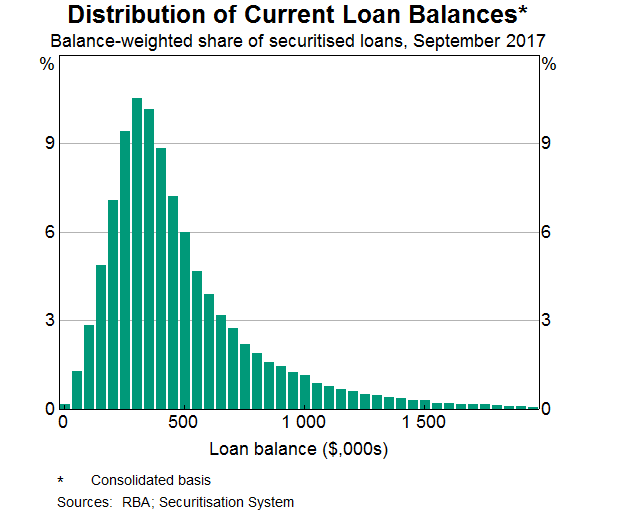
Let's look at owner-occupier and investor loans separately (Graph 2). The distribution of loan size is similar for the two groups but there is a greater proportion of large investor loans. This could reflect the tax incentives for investors to take on and sustain more leverage than owner-occupiers, maximising the amount of funds borrowed and limiting repayments. But it also reflects that investors appear to have a higher ability to pay off larger loans. For each mortgage in the Securitisation Dataset we also have information on the borrower, including their income. We find that borrowers with investor loans typically have higher incomes than those with owner-occupier loans and so have a greater borrowing capacity.
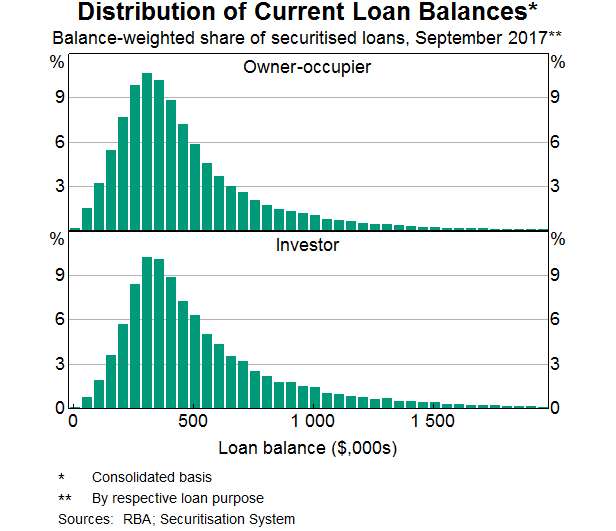
The loan-to-valuation ratio (LVR) is an important indicator of the riskiness of a loan. Here we show the distribution for LVRs based on the current loan balance and the most recent available property valuation for mortgages issued over the past two years (Graph 3).[6] You can see a concentration of loans with LVRs between 70 to 80 per cent – around one-third of loans are in that group – but only a small share of loans have LVRs higher than that. This reflects a few factors. Banks limit loans with LVRs (at origination) above 80 per cent, and these high-LVR borrowers are typically required to pay for lenders' mortgage insurance. Also, credit rating agencies apply large penalty factors in their credit risk assessments of high-LVR loans in a collateral pool. So it's not surprising that there are relatively fewer high-LVR loans in the Securitisation Dataset compared with the broader population of loans.
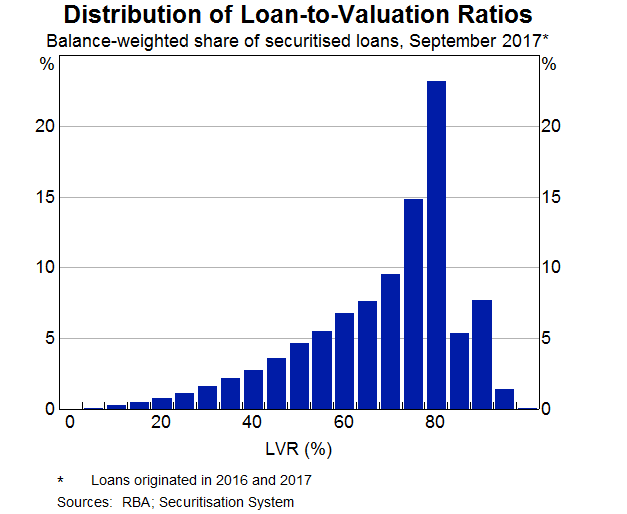
Let's turn to investor and interest-only loans; these have received some attention from regulators in recent years. This has included measures by the Australian Prudential Regulation Authority (APRA) to tighten lending standards on these types of loans.[7] The next graph shows the share of investor and interest-only loans in the Securitisation Dataset and a measure from APRA that covers the broader housing loan market (Graph 4). The first thing to note is that marketed securities have a lower share of investor and interest-only loans than the general population captured by the APRA data. For self-securitisations, these shares are more closely aligned to the composition of the banks' total mortgage portfolio. The second point of interest is the very recent large decline in interest-only loan shares in self-securitisations, which is consistent with changes in the broader stock of outstanding mortgages; these declines have occurred alongside measures by APRA to limit new interest-only lending.
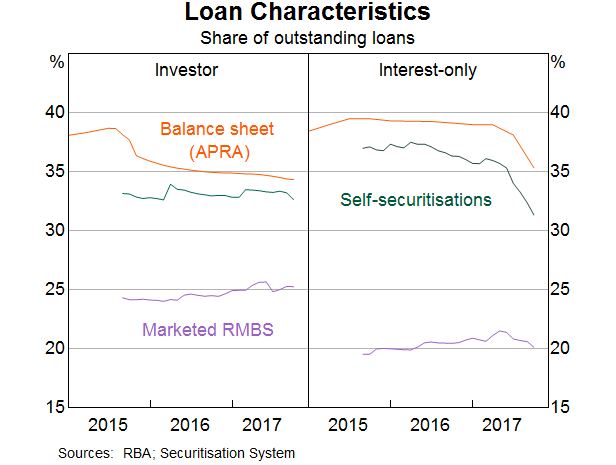
To summarise so far, we have looked at a number of characteristics of securitised mortgages that can be associated with the riskiness of these loans, in particular LVRs and whether they are investor or interest-only loans. Two things stand out: there is a wide distribution of these characteristics across different loans and, on average, securitised loans appear to be no riskier than the broader population of mortgages, at least on these metrics.
Mortgage Interest Rates
Variation in interest rates across loans is an important way for lenders to account for the different risks of mortgages. More creditworthy borrowers or lower-risk mortgages are typically offered lower interest rates, while borrowers with higher-risk mortgages would expect to pay higher interest rates. Interest rates on mortgages may also be influenced by other factors such as competition between lenders, bank funding costs, the regulatory environment and policy settings.
There are different types of measures readily available when assessing mortgage interest rates, such as standard variable rates or package rates. However, these measures do not necessarily reflect interest rates actually paid, since banks typically apply unadvertised discounts. Some of the variation in rates actually paid reflects variation in creditworthiness across borrowers. The Securitisation Dataset includes the actual interest rate paid on each mortgage and so can provide both timely and granular insights into housing interest rates that are not available from many other sources.
The next graph shows the distribution of interest rates paid on variable-rate mortgages across different lenders (Graph 5). The major banks offer a wide range of interest rates but the distribution is comparable to smaller banks. There is an even wider range of interest rates offered by non-bank lenders. This wider range to a large extent reflects that this category covers a variety of lenders targeting different types of borrowers and mortgages. There are some non-bank lenders that offer products with a similar level of interest rates to the banks. Other non-bank lenders specialise in providing riskier mortgages, such as to borrowers that require ‘alternative’ or low-documentation loans or have impaired credit histories.
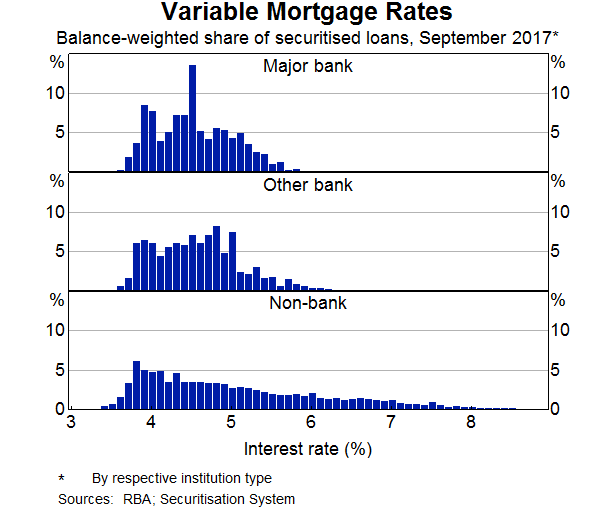
The most common mortgages in the Australian housing market are owner-occupier loans with principal-and-interest repayments. So, let's look at the distribution of interest rates paid for this type of loan in more detail, focusing on loans of the major banks (Graph 6). On the graph are marked three other interest rate measures. The line on the right is the relevant standard variable rate (SVR). Very few borrowers actually pay the SVR (or a higher interest rate); rather, borrowers are generally offered a discount relative to this reference rate. The discounts offered vary by borrower and lender, and also vary over time.
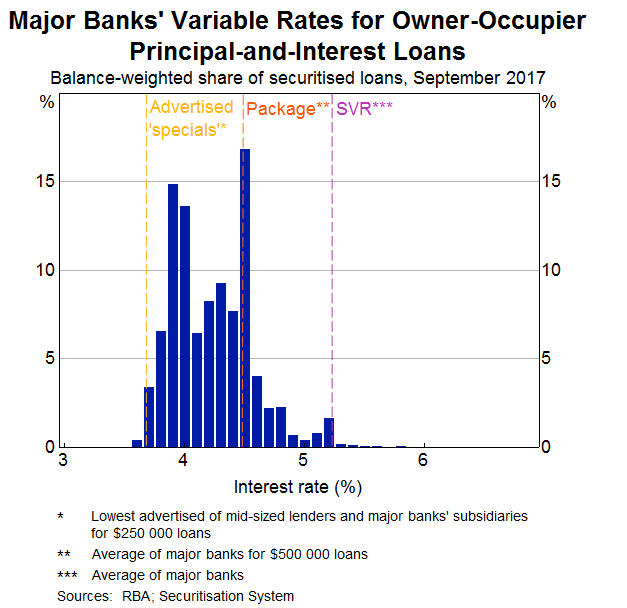
The second type of interest rate indicated, the middle vertical line in the graph, is the average ‘package’ rate. A typical package mortgage product has additional features beyond the ‘basic’ mortgage (such as an offset account) and may be bundled with other products (such as a credit card). Packages often include advertised discounts. A large share of loans has an interest rate consistent with the average package rate; however, the majority of loans have an interest rate below the average package rate.
The line furthest to the left shows the advertised ‘specials’ rate. Only a small share of loans in the dataset has an interest rate consistent with this lowest advertised rate. This may be because not many borrowers either qualify or seek loans at the advertised specials rate. Another reason is that advertised specials are interest rates on new loans, and new loans have attracted in recent years larger discounts compared with existing loans, as I will discuss later.[8]
For the major banks, the interest rates on most loans are within the range set by the advertised specials rate and the package rate. Preliminary econometric analysis suggests that LVRs and loan size are important determinants of the discount offered to borrowers. Large loans typically have lower interest rates. One factor is that the loan size a borrower qualifies for is correlated with the borrower's net income, which, in turn, is correlated with a better ability to repay. Also, borrowers seeking larger loans may have more bargaining power to negotiate greater discounts given the fixed costs associated with issuing loans.
The data shown in the distributions can be aggregated to provide a measure for the average outstanding interest rate on existing loans (Graph 7). (You may have seen similar graphs in some of our recent publications; the data underlying these graphs are from the Securitisation Dataset.[9]) The outstanding interest rates on the four main types of mortgages – owner-occupier or investor, and principal-and-interest or interest-only – have changed over the past years partly in response to regulatory measures. These changes are also evident in the variable interest rate loans in the Securitisation Dataset. In the latter part of 2015, investor loans became more expensive compared with owner-occupier loans. This was in response to regulatory measures designed to limit the pace of growth of investor credit. Over the past year, regulatory measures have focused on limiting new interest-only lending. In response, lenders have increased rates on interest-only loans several times while lowering rates on principal-and-interest loans.
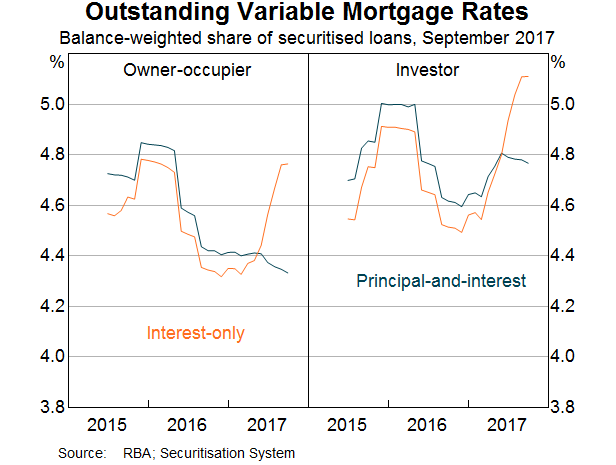
The response of the banks to the regulatory changes can also be measured by examining how the distribution of interest rates has changed. Here you can see a stacked histogram (Graph 8). For each interest rate band on the horizontal axes, it shows the share of loans that have either principal-and-interest (blue bars) or interest-only (orange bars) repayments. You can see the large overlap between the two distributions for interest-only and principal-and-interest loans before the introduction of limits on new interest-only lending. There has since been a marked repricing of loans within those two groups in response to the regulatory measures. You can now see a clear separation between the distributions (Graph 9). Interest rates on interest-only loans have increased and the distribution has shifted towards the right, following the large rate increases for both owner-occupier and investor loans in that category. Mortgages with an interest rate below 4 per cent are now almost exclusively principal-and-interest loans.
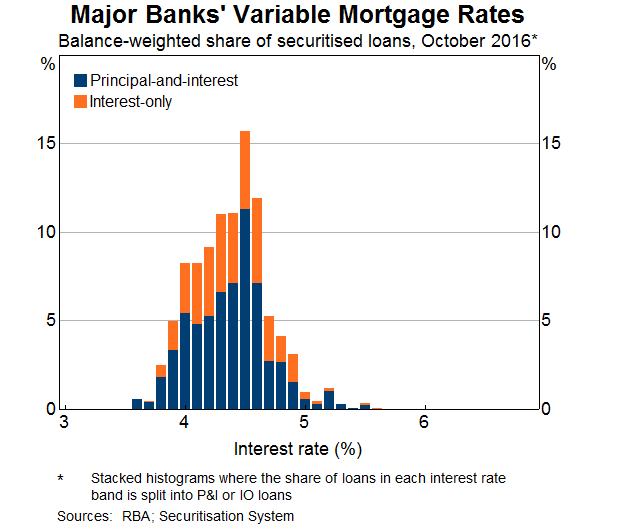
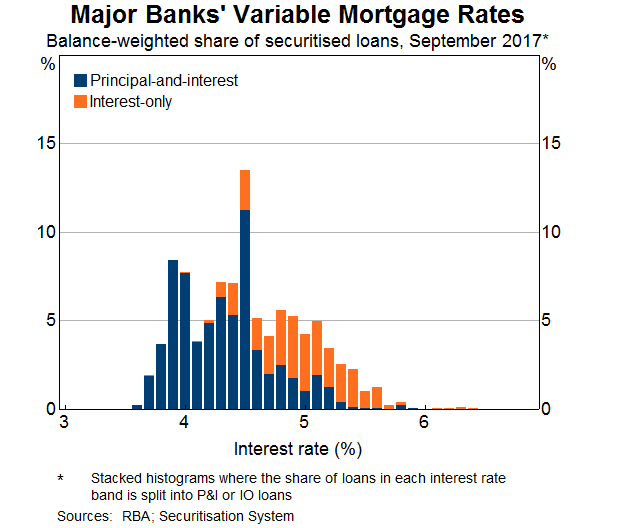
The distribution of principal-and-interest loans has also changed following the regulatory measures. There is now a greater proportion of principal-and-interest loans with an interest rate below 4 per cent, due to the lower rates applied to owner-occupier loans, and there has reportedly been increased competition for these types of loans.
So far, we have looked at interest rates on all outstanding loans. As indicated earlier, another important measure is the interest rate for newer loans. While changes to SVRs, or reference rates, are directly transmitted to all borrowers with variable-rate loans, interest rates offered to new borrowers may move independently of reference rates depending on lenders' discounting decisions. In this graph I show estimates obtained from the Securitisation Dataset for the interest rate on recently issued mortgages (Graph 10). As you can see, the average interest rate on new loans has been consistently lower than the interest rate on outstanding mortgages over the past few years. Over the past 12 months, the degree of discounting has in fact increased. This has been the case for both owner-occupier and investor loans. The increase in interest rate discounts offered to new borrowers over the past year suggests that competition for customers is stronger for new borrowers than for existing borrowers. The Reserve Bank has noted the apparent difference in competition for new and existing borrowers in its recent submission to the Productivity Commission's Inquiry into ‘Competition in the Financial System’.

In this second part of my talk, I have highlighted three insights that we have gained from the dataset on mortgage interest rates actually paid by different borrowers and how they vary over time. First, as is the case with the size and LVRs of mortgages, there is a wide distribution of interest rates paid across different types of mortgages and borrowers. Second, in response to recent regulatory measures, these distributions have changed. And third, we have found that advertised and unadvertised discounts to reference rates are commonplace. These discounts have increased in recent years, such that new borrowers often pay lower interest rates than existing borrowers for similar types of mortgages.
Conclusions
I have shared with you today some of the mortgage insights that we have been able to gain from the Securitisation Dataset.
We have found this dataset to be a rich source of detailed information that can help us to better understand broader developments in the mortgage market. One area is in assessing trends in the characteristics and quality of housing loans that require loan-level data. Another area where these data are valuable is in assessing the competitive environment in the mortgage market.
The primary purpose of these data to us is, of course, our need to be able to assess risks on the Reserve Bank's balance sheet. The granular data in the dataset allows us to thoroughly assess the credit quality of the asset-backed securities accepted as collateral in our domestic market operations. I look forward to sharing some of the work we are doing in that area at a future occasion.
Thank you.
Endnotes
I would like to thank Michael Tran and Michelle Bergmann for their invaluable help in preparing this speech. [*]
For more detail, see Aylmer C (2016), ‘Towards a More Transparent Securitisation Market’, Address to Australian Securitisation Conference, Sydney, 22 November. [1]
I use the term banks here to refer to all authorised deposit-taking institutions (ADIs), namely banks, building societies and credit unions. [2]
More detail on permitted users and data access can be found on <https://www.rba.gov.au/securitisations/> and <http://www.securitisation.com.au/standards>. [3]
Other assets, such as commercial property mortgages and car loans, constitute only about 2 per cent of the loan pool. [4]
Self-securitisations are used by participating banks for the Committed Liquidity Facility to satisfy the regulatory requirements for APRA's Liquidity Coverage Ratio. For more information, see Debelle G (2014), ‘Liquidity’, Speech at the 27th Australasian Finance and Banking Conference, Sydney, 16 December. Self-securitisations are also used to cover payment settlements that occur outside business hours via ‘open repo’ transactions with the Reserve Bank. [5]
We restrict the LVRs shown here to mortgages issued in the past two years, since the most recent available valuation is often the valuation at origination. Looking at the whole data set (including LVRs for older loans), the main conclusions are similar, although there are more loans with lower LVRs, reflecting loan repayments over time. [6]
For more details, see APRA (2017), ‘APRA Announces Further Measures to Reinforce Sound Residential Mortgage Lending Practices’, Media Release No 17.11, 31 March. [7]
New loans represent only a small share of total outstanding loans. This is even more so the case for data from securitised loans, which are usually seasoned, that is aged, somewhat before they are securitised. [8]
See, for example, RBA (Reserve Bank of Australia) (2017), Statement of Monetary Policy, November; RBA (2017), ‘Competition in the Financial System’, Submission to the Productivity Commission Inquiry, September; and Kent C (2017), ‘Some Innovative Mortgage Data’, Address to Moody's Analytics Australia Conference 2017, Sydney, 14 August. [9]
